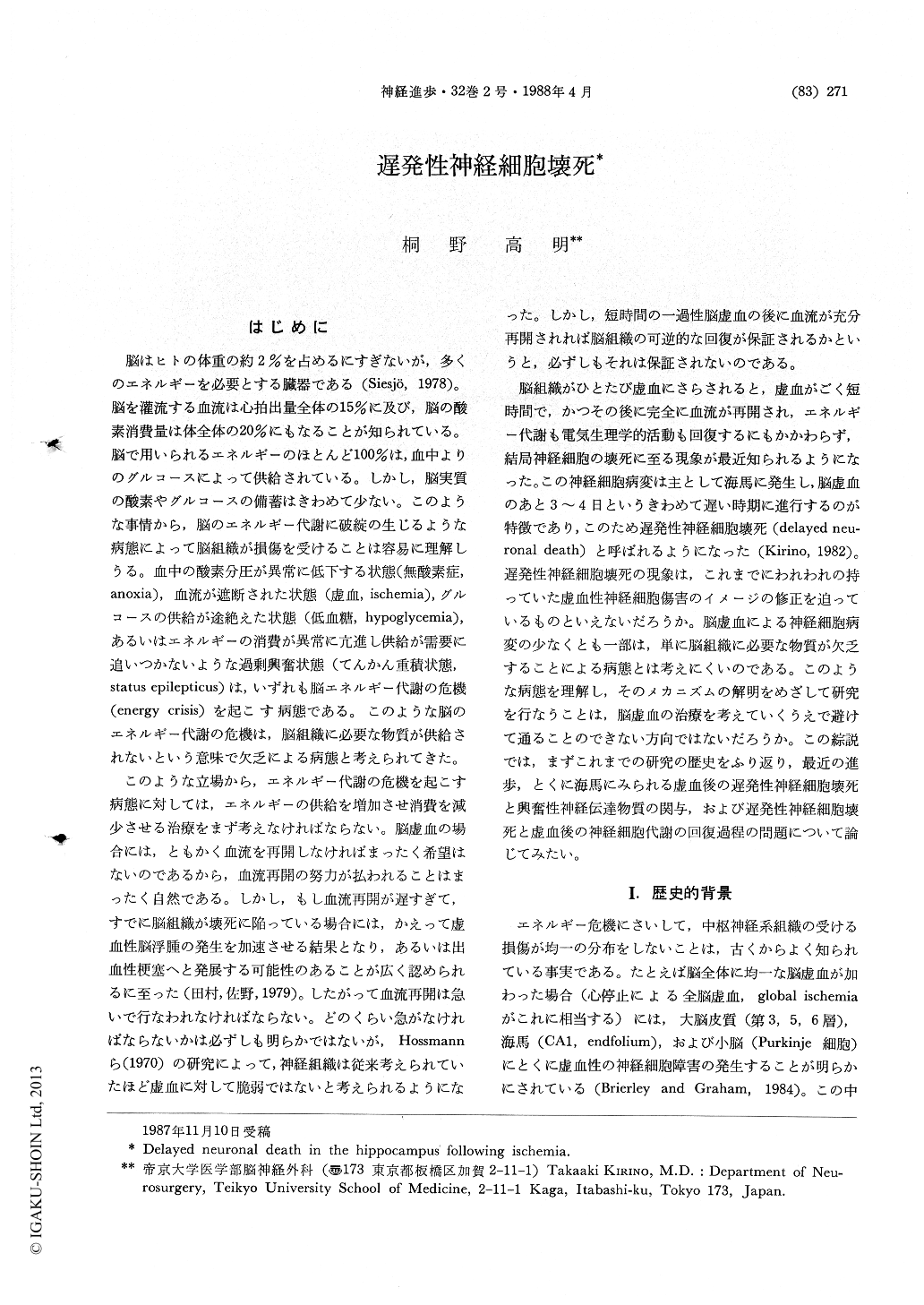Japanese
English
- 有料閲覧
- Abstract 文献概要
- 1ページ目 Look Inside
はじめに
脳はヒトの体重の約2%を占めるにすぎないが,多くのエネルギーを必要とする臓器である(Siesjö,1978)。脳を灌流する血流は心拍出量全体の15%に及び,脳の酸素消費量は体全体の20%にもなることが知られている。脳で用いられるエネルギーのほとんど100%は,血中よりのグルコースによって供給されている。しかし,脳実質の酸素やグルコースの備蓄はきわめて少ない。このような事情から,脳のエネルギー代謝に破綻の生じるような病態によって脳組織が損傷を受けることは容易に理解しうる。血中の酸素分圧が異常に低下する状態(無酸素症,anoxia),血流が遮断された状態(虚血,ischemia),グルコースの供給が途絶えた状態(低血糖,hypoglycemia),あるいはエネルギーの消費が異常に亢進し供給が需要に追いつかないような過剰興奮状態(てんかん重積状態,status epilepticus)は,いずれも脳エネルギー代謝の危機(energy crisis)を起こす病態である。このような脳のエネルギー代謝の危機は,脳組織に必要な物質が供給されないという意味で欠乏による病態と考えられてきた。
このような立場から,エネルギー代謝の危機を起こす病態に対しては,エネルギーの供給を増加させ消費を減少させる治療をまず考えなければならない。
The brain is the most vulnerable organ to a deficiency state in which appropriate supply of substances essential to maintain cellular energy metabolism is disturbed. Following brief cerebral ischemia, the hippocampus is well known to be exceptionally susceptible to ischemic damage. The pathological change in the hippocampus following ischemia is strikingly slow. This "delayed neuronal death" has come to be realized quite different from traditionally known ischemic brain damage. Neurons in CA1 remain morphologically normal for longer than 24 hours. The hippocam-pal CA1 neurons completely recover in terms of energy metabolism and electrophysiology and then succumb. An excitotoxic mechanism is postulated as a cause of hippocampal delayed neuronal death. Glutamate receptors are abun-dantly found in the hippocampus and an increase of extracelluar glutamate is actually observed during and after ischemia. An increase of glucose metabolism and an electrophysiological hyperac-tivity are also seen. Deprivation of excitatory input to this area (deafferentation) has proved to be protective when CA1 neurons are subjected to brief ischemia. A dispersed culture experiment using fetal hippocampal neurons has also shown an excitotoxic mechanism. All of these results strongly suggest an important role of excitatory neurotransmission. Excessive excitation of CA1 neurons has shown to induce an intracellular overloading of Ca2+ in CA1 pyramidal cells. Excessive Ca2+ entry can, in turn, cause a detri-mental effect on neurons by proteolysis or lipolysis. These results have suggested that neurons are killed by membrane-mediated phenomenon and thus drug treatment may protect neurons from ischemic damage. Non-specific drugs such as phenytoin, pentobarbital, and diazepam have been reported to have a favorable effect. More specific substances such as NMDA blockers or Ca2+ entry blockers have been shown to possess a promising effect. Excitotoxic theory, however, cannot appropriately account for the delay of ischemic hippocampal damage following ischemia. There is a free interval between the increase of extracellular excitatory amino acid and the first sign of neuronal necrosis. Recent progress is still not likely to fully explain delayed cell death. A suppression of protein synthesis in the hippocam-pus has recently been noticed. Neurons in CA1 never shows a sign of recovery until massive necrosis. Metabolic derangement following brief ischemia seems to have serious effects on the survival of ischemic neurons. These recent advan-ces in this field are reviewed in this communi-cation.

Copyright © 1988, Igaku-Shoin Ltd. All rights reserved.


